Desert lizards an be kept in a variety of terrariums that mirror a dry, arid and low humidity environment. Popular species of desert lizards include the Mali Uromastyx, Leopard Gecko and Bearded Dragon. In general, these lizards grow up to 10 inches and larger, primarily eat insects (insectivores), are nocturnal and live alone. As pets, these lizards are appropriate, with supervision, for children age 10 and older. The typical terrarium is simple and includes sand as a substrate along with items found in the native environment such as rocks and plants. Humidity levels are low, so aquarium tops should be screened to allow for the release of any moisture.
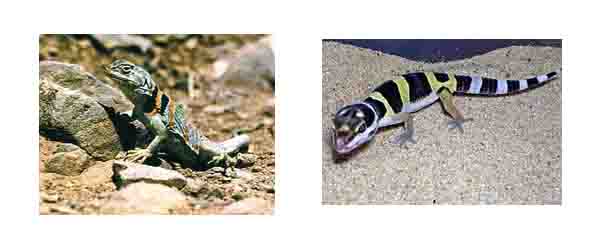 The Texas Collared Lizard (left) and the Leopard Gecko (right) are popular home pet lizards
The Texas Collared Lizard (left) and the Leopard Gecko (right) are popular home pet lizards
Source: Wikimedia
Desert Lizard Habitats
- Habitat Size: Pet lizards can be kept in a terrarium that is 12 in. x 30 in. or larger depending on size and activity level.
- Substrate: Sand is an acceptable substrate. The bottom layer of the sand substrate should be moistened using a pipe which directs water to the area.
- Furniture: Depending on the species, some need climbing objects such as piles of flat rocks, while others such as Horned Lizards do not need to climb. Other popular options include:
- Basking Rocks
- Potted plants that are at home in arid environments
- Cork bark for hiding areas
- Opuntia Cactus Skeletons
- Temperature: The terrarium should be kept at 105 to 110F (40.6 to 43C).
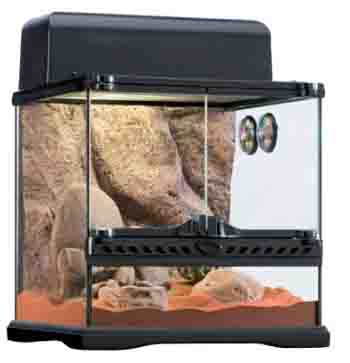 A Lizard Desert Habitat Kit Like this one is an Easy Way for Hobbyists to set up a Lizard Cage
A Lizard Desert Habitat Kit Like this one is an Easy Way for Hobbyists to set up a Lizard Cage
Source: Amazon
Desert Lizard Species
As mentioned above, the most popular type of desert lizard is the Leopard Gecko. Other popular pet lizard species are the North African Lizard Dab Lizard and the Texas collared lizard.
Horned Lizards (phrynosoma, a desert lizard) and Spiny Lizards (Swifts)
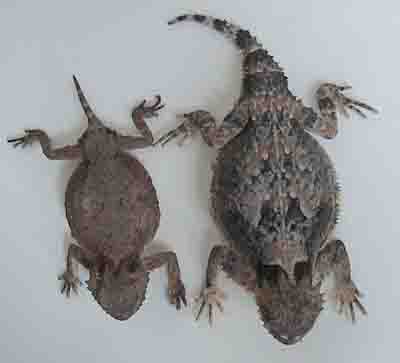 Horned Desert Lizards
Horned Desert Lizards
Source: Wikimedia/Dawson
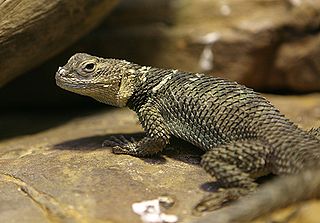 Spiny Lizards (Swifts)
Spiny Lizards (Swifts)
Source: Houston Zoo/Wikimedia
These desert lizards have similar characteristics (nasal psychology) but are very different in behavior. The Horned Lizard is slow and squat, while the Spiny Lizard or Swift is thinner and fast. The Fence Swift and Horned Lizard are both popular among hobbyists.
Horned Lizard Habitat:
- Habitat: The terrarium size depends on the size of the lizard and the number to be kept in captivity. Minimum dimensions are 12 in. x 30 in.
- Substrate: Sand
- Furniture: Flat rocks
- Temperature: 105F to 110F (50.6C to 43C)
- Low humidity
- Lizard Cage Size: Depends on size of lizard
- Diet: Ants, which make this type of lizard difficult to care for in captivity
- Swift Spiny Lizard Habitat Exceptions:
- Furniture: Limbs for climbing, flat rocks
- Lizard Cage Size: 12 inches x 48 inches
Desert Skink Lizards
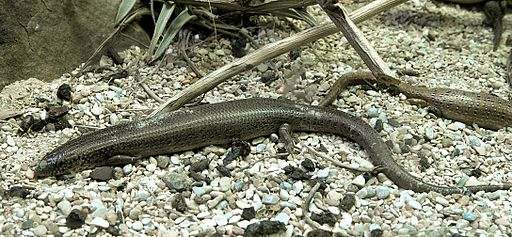 Ocellatus Desert Skink
Ocellatus Desert Skink
Source: Jebulon/Wikimedia
Skinks live in the Savanna or Desert. Ocellated or Barrel Skinks are a popular lizard breed in America and Europe. They are kept in a sand terrarium, but need to maintain the proper sand/moisture balance. Sinks are small lizards that are not commonly kept in home habitat. They can be kept in areas that are 12 in x 30 (20 gallon terrarium). Other types of skinks include the Great Plains Skink, Schneider's and Algerian Skink. The later is cold tolerant and eats insects
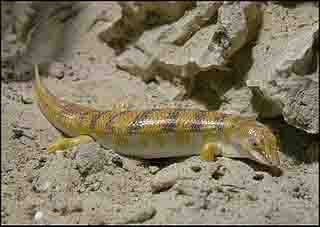 Sandfish Desert Lizard
Sandfish Desert Lizard
Source: Wikimedia/Factumquintus
Another type of skink lizard is the Sandfish. These desert lizards require a large terrarium with up to a foot of fine sand at the bottom. Keep the bottom layer of sand moist with trickling water fed via a PVC pipe. Keep one end of the terrarium at 110F (43C) and the other end at 85F (29C).
Desert Geckos As Pets
Geckos are popular desert lizards as pets due to their small size and ability to keep in a smaller aquarium. They are slower moving, and relatively easy to care for.
Types of Desert Geckos:
- Leopard Geckos: The Leopard Gecko is an extremely popular lizard commonly found in pet stores. The lizard feeds on crickets and mealworms. A leopard gecko can live as long as 15 to 22 years. These lizards are nocturnal, making them more active at night. To observe their behaviors you may need a special red or night bulb.
- Habitats can be as small as a 10 gallon aquarium. An owner can keep 3 females and one male in a tank. Place an inch of sand on bottom of tank. Other acceptable substrates are small pebbles, ground oyster shell. Like caves, cork bark tubes or curved pieces of pine bark.
- Keep clean water in habitat at all times in a shallow dish.
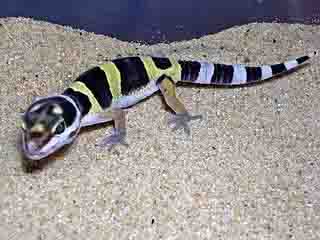 Juvenile Leopard Gecko
Juvenile Leopard Gecko
Source: Wikimedia/Jerome66
- African Fat Tailed Geckos: Prefer that the aquarium be a bit more humid that an aquarium kept for leopard Geckos. Set up the aquarium in the same way, but to raise the humidity, use bark nuggets in the terrarium (they hold moisture). Also include un-milled sphagnum moss. Keep a low water dish in the tank.
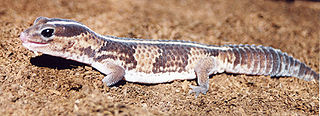 African Fat Tailed Gecko
African Fat Tailed Gecko
Source: Wikimedia/Hexasoft
Collared Lizards
- Collared lizards in the wild are found near boulders. These lizards should be kept only one to a tank. The minimum lizard habitat size is 18 inches x 48 inches. Basking area should be kept up to 115F (46C). Also provide a cooler area for resting. Nighttime temperatures can be 60F (18V). This species is best know for showing no fear. The Texas collard lizard is a popular choice due to its stunning colors and ability to adapt to captivity.
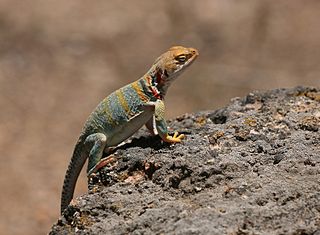 Collared Lizard is found along roadsides often sitting on top of a boulder as shown here
Collared Lizard is found along roadsides often sitting on top of a boulder as shown here
Source: Wikimedia, Daniel Schwan
Chuckwalla Lizards
Chuckwallas are large desert lizards that are not very active. When grooming, one Chuckwalla will bite the skin off of the other.
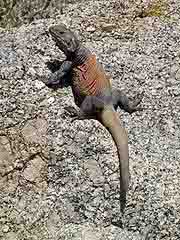 Chuckwalla Desert Lizard Photographed in Scottsdale, Arizona, USA
Chuckwalla Desert Lizard Photographed in Scottsdale, Arizona, USA
Source: Wikimedia, Azhikerdude
Desert Iguana (Dipso)
- Lacertid Lizards: Jeweled and Green Lacertas: These savannah lizards grow to 18 inches to 32 inches in length. Lacertid lizard diet is small insects, rodents and small birds. Will eat fruit and blossoms. Require large cages since they like to move and climb.
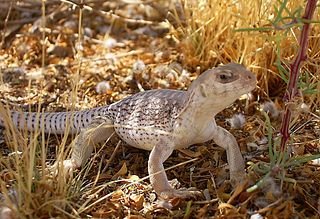 Desert Iguana
Desert Iguana
Source: Wikimedia, Ekeb
As the name implies, this type of Iguana prefers a desert terrarium. In terms of habitat, create a hot spot and use a firm substrate be burrowed, such as rocks. They are herbivores mixed greens (avoid oxalic acid), shredded carrots, blossoms and dandelion leaves. Desert Iguanas can live 15 years or more.
Spiny-tailed Agamids
These lizards require high levels of UVB lighting and a sand/clay substrate. They like to burrow. They will drink from a flat dish. They prefer to eat tough and non succulent leaves and blossoms of Arternesia.
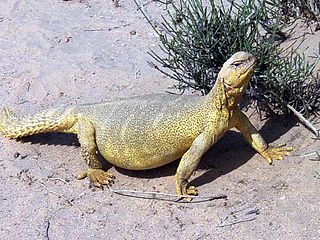 Spiny Tailed Agamid photographed in the Kuwaiti desert
Spiny Tailed Agamid photographed in the Kuwaiti desert
Source: Wikimedia, Maj Kathleen A Hoard, US Marine Corp
Night Lizards
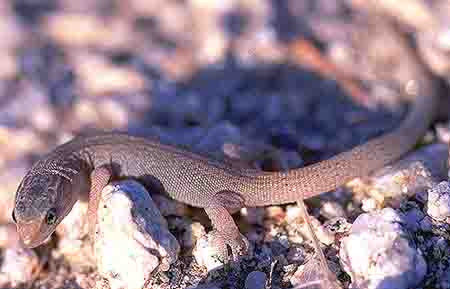 Night Desert Lizard
Night Desert Lizard
Source: United States Geological Survey
Like others on this page, create a desert terrarium to house this lizard. They like to bask underneath a warm rock or bark. They eat small crickets, mealworms, beetles, grasshoppers and other small insects.
Bearded Dragons (Agamidae Pogona)
Bearded Dragons or Beardies as they are affectionately called can be found in a variety of habitats including everything from deserts to heavily forested areas. The lizard originally comes from Australia, but can now be found in other regions. There are eight recognized species which grow to no more than 2 feet in length (most grow to between 6 to 12 inches), making them a popular pet lizard. Baby bearded dragons cost between $25 and $35 dollars. Adults can cost several hundred dollars. Inspect the baby when purchased in a pet store for appetite (ask it to be fed), and check that eyes are clear, and all toes are in place.
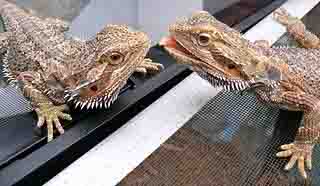 Australian Bearded Dragon
Australian Bearded Dragon
Source: Wikimedia, Steve Jurvetson - Menlo Park, USA
- Diet: Bearded Dragons are easy to feed. They eat plants, animal and can be coaxed into eating specially formulated pellets.
- Vegetables: Diced carrots, collard greens, dandelion flowers/leaves, frozen mixed vegetables, kale, mustard greens
- Insects: Gut loaded (pre-fed with nutrients) crickets, mealworms
- Rodents: Small mice
- Commercial Diets: Pellets
- Handling: This might be the easiest lizard to handle. They sit still in palm (out of fear) and will not bite or scratch.
- Habitat: Glass terrarium with a mesh screen top.
- Juveniles: lizard cage with is 3ft to 4ft in length.
- Adults: 6 ft in length, 16 in to 20 in wide.
- Substrates: Print free newsprint in first layer, topped with either sand or Calci-Sand which generally considered safe and digestible, although others believe that it can lead to an impaction or gastrointestinal blockage problem.
- Furniture: Some type of branch or shelter box or reptile cage to perch on top of or to sleep inside.
- Diurnal: Bearded Dragons are awake and active during the day.
- Appeal: The lizard makes a waving motion with an arm that delights owners and visitors.
- Temperature: Like other lizards, bearded dragons require a cool zone and a hot zone. Daytime temperatures should range from 80F to 85F. Basking areas should be at 90F to 93F. At night, the entire terrarium, hot and cold, can be set to the same temperature which is 65F to 75F.
- Lighting: Bearded dragons require 10 hours of sunlight per day. Use natural unfiltered light or full spectrum lighting.
- Water: Clean water provided in a dish.
Related Articles
How to Select Lizard Aquariums and Cages
Lizard Food and Nutrition
Signs of Lizard Diseases and other Health Concerns
Water Lizards as Pets
Woodland and Anole Lizards as Pets
Types of Lizards
Have a Lizard Related Question for our Vet? We Will Answer it for Free!
Do you need some pet lizard advice? Just ask a question and our Vet will answer it as soon as possible.
If your question is medical or behavior-related, please include information such as species, age, diet, habitat, and anything related to the medical history of your lizard.
Please upload a picture of your lizard, especially if you believe it will help the Veterinarian. Please know that we receive many questions and answer them on a first-come, first-served basis. If you need an immediate response, we suggest you use this online veterinary service that is available now to answer your questions.